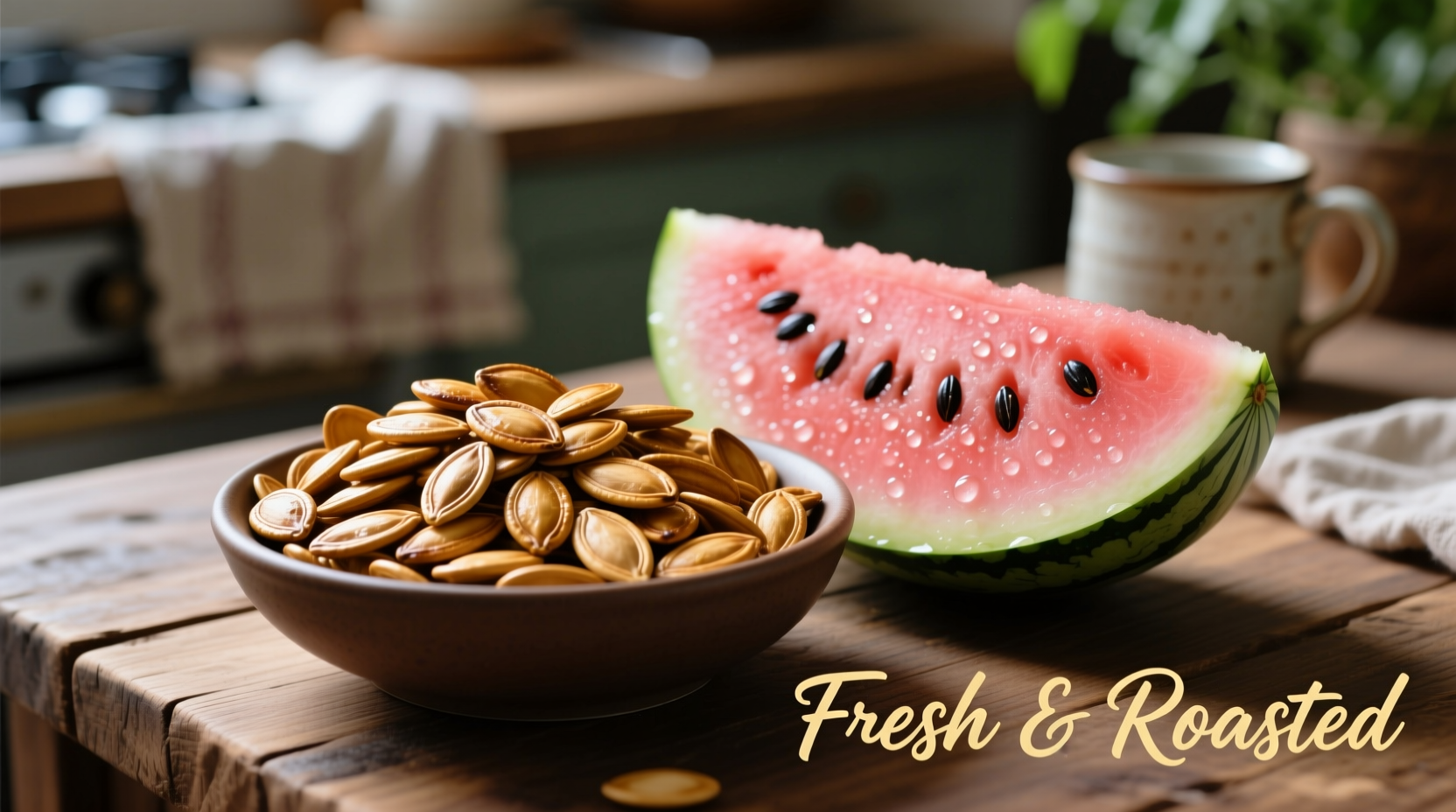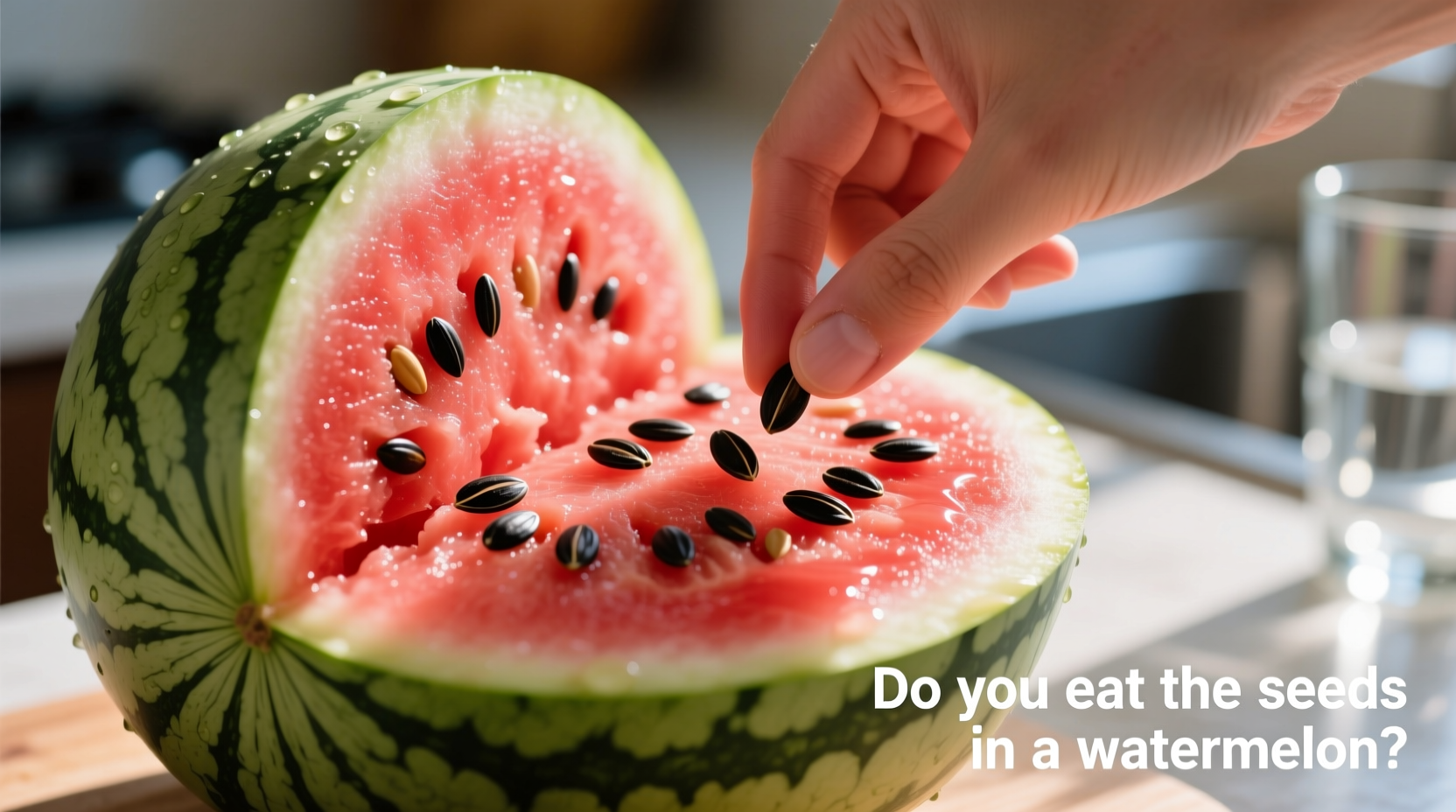Wondering whether those little black specks in your summer favorite are friend or foe? You're not alone. Millions search "do you eat the seeds in a watermelon" each season, torn between spitting etiquette and potential nutrition. Let's cut through the confusion with science-backed facts and practical techniques you can use today.
The Truth About Watermelon Seeds: What You're Actually Eating
Watermelon seeds fall into two categories you'll encounter:
- Mature black seeds - Found in traditional varieties, these hard seeds contain the highest nutritional value
- Immature white seeds - Common in "seedless" watermelons (which are 99% seedless), these soft seeds are completely edible
According to USDA FoodData Central, just one ounce (28g) of dried watermelon seeds provides:
| Nutrient | Amount | Daily Value % |
|---|---|---|
| Protein | 8g | 16% |
| Magnesium | 140mg | 33% |
| Zinc | 2.5mg | 23% |
| Healthy Fats | 11g | 17% |
This nutritional profile makes watermelon seeds comparable to pumpkin seeds in health benefits. Unlike apple or cherry pits, watermelon seeds contain no cyanide compounds, making them completely safe for consumption according to the National Watermelon Promotion Board's food safety guidelines.

Global Seed-Eating Traditions: How Different Cultures Handle Watermelon Seeds
While Americans often spit seeds, many cultures have embraced them as culinary treasures. In West Africa and parts of Asia, watermelon seeds are:
- Roasted with spices as street snacks
- Ground into traditional sauces
- Pressed for their nutritious oil
The Food and Agriculture Organization documents how Nigerian women traditionally ferment and roast watermelon seeds to create egusi, a protein-rich ingredient used in soups and stews. This centuries-old practice transforms what Americans consider waste into valuable nutrition.
Practical Seed Strategies: What to Do With Watermelon Seeds
Whether you're enjoying a picnic or prepping for a family barbecue, here are actionable approaches:
For Immediate Consumption
- Spitting technique: Place seed on tongue, purse lips, and gently blow - works best for large gatherings
- Seed collection: Keep a small bowl nearby to collect seeds as you eat
- White seed approach: In seedless varieties, simply chew and swallow the soft white seeds
For Future Use
Don't waste those black seeds! Transform them into delicious snacks:
- Rinse collected seeds thoroughly
- Soak in salt water for 10 minutes
- Spread on baking sheet and dry at 325°F for 15-20 minutes
- Toss with olive oil and your favorite spices (try chili-lime or rosemary-garlic)
Food science research published in the Journal of Food Science and Technology confirms that roasting enhances both flavor and nutrient bioavailability while maintaining the seeds' healthy fat profile.
Safety Considerations: When to Exercise Caution
While watermelon seeds pose minimal risks, keep these points in mind:
- For children: Teach proper spitting technique to prevent choking hazards
- Digestive sensitivity: Those with digestive disorders may want to remove seeds initially
- Quantity: Enjoy in moderation as part of balanced diet (seeds are calorie-dense)
Unlike fruit pits containing amygdalin (which converts to cyanide), watermelon seeds present no toxicity concerns according to comprehensive food safety databases. The primary consideration is simply personal preference and digestive comfort.
Maximizing Your Watermelon Experience
Consider these pro tips for seed management:
- Variety selection: Choose seedless varieties (actually "spittable") for effortless eating
- Cutting technique: Slice watermelon into wedges rather than cubes for easier seed removal
- Storage: Keep dried seeds in airtight container for up to 3 months
- Waste reduction: Save seeds from multiple melons to make a larger roasted batch
Professional chefs often recommend embracing the seeds rather than fighting them. As Antonio Rodriguez notes, "The most sustainable approach is viewing seeds as an ingredient, not waste. You'll gain nutrition while reducing food waste - a win-win for your health and the planet."
Frequently Asked Questions
Are watermelon seeds poisonous?
No, watermelon seeds are completely non-toxic. Unlike apple or cherry pits, they contain no cyanide compounds. They're safe for consumption and packed with nutrients including protein, magnesium, and healthy fats.
Can you eat the white seeds in seedless watermelon?
Yes, the white seeds in seedless watermelon are immature and completely edible. They're soft, have minimal flavor, and pass through your digestive system easily. Most people eat them along with the fruit without noticing.
What are the health benefits of eating watermelon seeds?
Watermelon seeds provide protein (8g per ounce), magnesium (33% DV), zinc (23% DV), and healthy fats. They support heart health, muscle function, and immune system support. Roasting enhances nutrient absorption while maintaining their nutritional profile.
How do you properly roast watermelon seeds?
Rinse seeds, soak in salt water for 10 minutes, then spread on a baking sheet. Dry at 325°F for 15-20 minutes until golden brown. Toss with olive oil and spices like chili powder, garlic, or rosemary for delicious homemade snacks.











 浙公网安备
33010002000092号
浙公网安备
33010002000092号 浙B2-20120091-4
浙B2-20120091-4